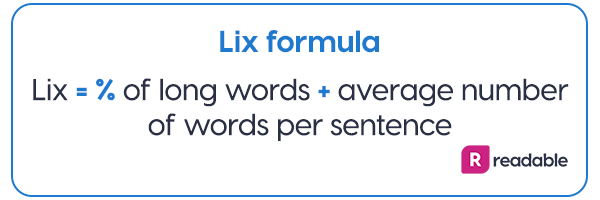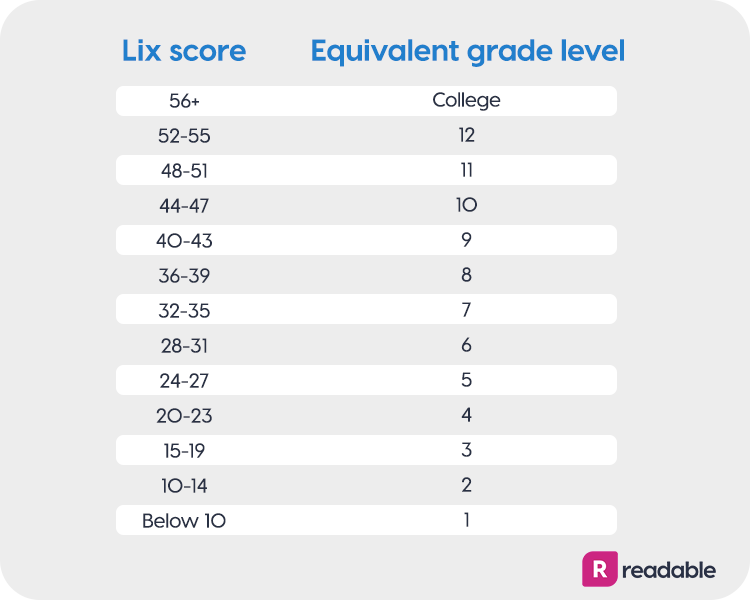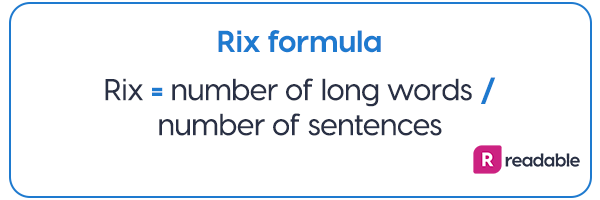Lix and Rix are formulas which are useful for several non-English languages. Find out how they are calculated and how best to use them.
What are Lix and Rix?
Lix and Rix are two versions of the same readability formula.
They both measure readability based on letter counting. They don't use the syllable counting method of many other formulas.
Syllable counting may prove inaccurate in non-English languages. Lix and Rix’s letter counting method is more suited to this purpose.
Where did the formulas come from?
Lix was developed in Sweden. It was created by Carl-Hugo Björnsson in 1968. He published it in a book called Läsbarhetsindex. Translated, this means ‘readability’. He called it ‘Lix’ for short. Compared to other celebrated formulas, it was obscure at the time of publication. All reporting on the formula was in Swedish.
Björnsson established a stable criterion to ensure accuracy. He had 162 books rated for readability by teachers and groups of students. The 162 texts included textbooks, fiction and technical literature. This ensured that a range of literature was represented.
At first, he considered numerous text features to measure against his criteria. These included: sentence length, complexity, unusual words, central words and different words.
He eliminated these to fewer variables which were consistently accurate. These included words and sentences, similarly to some other formulas.
Several other formulas count syllables and unfamiliar words. This works well with the English language but has limitations elsewhere. Lix calculates the percentage of words with seven or more letters.
The way Lix calculates sentences is similar to the Flesch formulas, Spache and Fry. It calculates average words per sentence. The word and sentence factors are weighted equally.
The Lix formula is:

The Rix formula was created over a decade later. This was by Jonathan Anderson, an Australian teacher. Anderson wanted to convert the formula to a grade level. He knew many teachers and librarians find a grade level useful.
As a basis for his own formula, he studied the validity of Lix.
He then determined cut-off points in the Lix score to convert them to grades. He validated this and replicated it in his modified formula - Rix. The criteria he used reflected an international reading study by RM Thorndike in 1973.
He used the same texts from this study to test Lix. Lix reasonably correlated with Fry. It ran no more than half a grade lower than Flesch. In a second validity study, he used cloze testing. This is a type of comprehension test. Subjects are asked to guess omitted words in a passage.
The cloze testing indicated a high level of accuracy of Lix. This was due to the wide range of texts the formula encompasses. Recall testing was also used to test the number of memorable content words. This also showed positive results regarding Lix’s accuracy.
Satisfied with this, Anderson made a conversion table.

He then created his own slightly modified formula and called it Rix. He promised it would be an even more simplified version of Lix. The formula for Rix is:

The results of Rix correlate almost perfectly with Lix.
When are Lix and Rix most useful?
Both formulas are useful for determining text difficulty for education. One advantage of Lix and Rix is that they are reliable for a wide range of ages. From texts for young children to adult reading material. For teachers and librarians, Lix and Rix are invaluable formulas for categorising books.
Lix has also been the subject of a study on the readability of several non-English languages. One study focused on the use of Lix with French, German, Greek and English texts.
It found that the study of readability for non-English texts had previously been limited. Lix is a promising solution for foreign language readability. This means that when translating for international readers, you can also check for readability.
Lix used to only be popular in Scandinavia - now, it is increasingly popular worldwide.
If you’re writing for the public, we recommend aiming for a Lix score of 40 or below. For Rix, a grade level of around 8.


